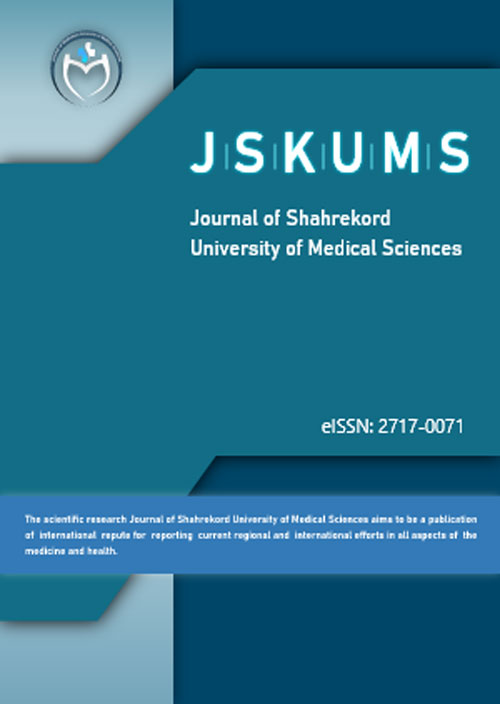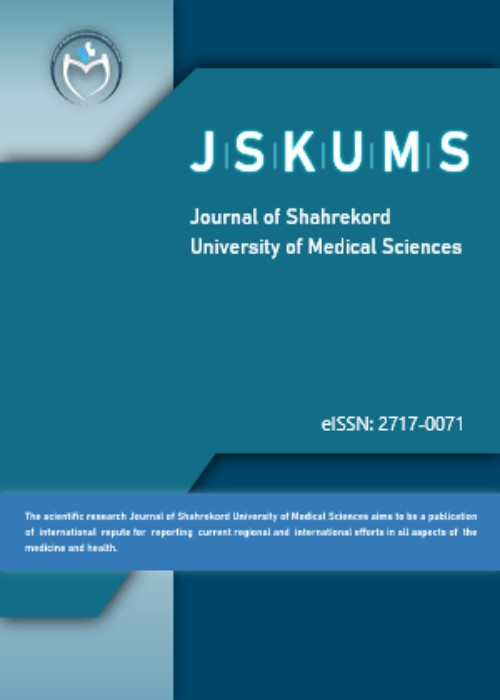فهرست مطالب

مجله دانشگاه علوم پزشکی شهرکرد
سال بیست و چهارم شماره 1 (پیاپی 114، Winter 2022)
- تاریخ انتشار: 1400/11/28
- تعداد عناوین: 8
-
-
Pages 1-6Background and aims
The presence of an appropriate scaffold at the wound site could significantly improve the healing process. In this study, we aimed to prepare a biomimetic nanocomposite scaffold composed of chitosan, gelatin, and 58S bioglass nanoparticles for skin tissue engineering.
MethodsThe nanocomposite scaffolds composed of chitosan, gelatin, and 58S bioglass nanoparticles were fabricated through electrospinning process. Then the cell viability assay was performed in order to evaluate the biological properties of the membranes. The optimum concentration of bioglass nanoparticles was determined for further studies. In vitro characterization was also performed to evaluate physicochemical properties of the scaffolds.
ResultsThe chitosan/gelatin scaffold containing 2% of 58S bioglass nanoparticles showed no cell toxicity, and the dermal fibroblasts were found capable of proliferation on the membrane. The in vitro results obtained from the scanning electron microscopy (SEM), attenuated total reflectance-Fourier transform infrared spectroscopy (ATR-FTIR), and porosity tests demonstrated the appropriate properties of the membrane as a scaffold for skin regeneration.
ConclusionsIt was concluded that a chitosan-gelatin membrane containing 2% of 58S bioglass nanoparticles had the potential to function as a scaffold to accelerate wound healing due to its suitable properties, such as high porosity, high surface/volume ratio, and excellent biocompatibility.
Keywords: Chitosan, Gelatin, Bioactive glass, Wound healing, Tissue engineering -
Pages 7-14Background and aims
COVID-19 is a pandemic and infectious disease with high morbidity and mortality rates as well as a global spread. This study aimed to investigate the clinical outcomes for patients afflicted with COVID-19 and treated with remdesivir.
MethodsIn this clinical trial study, patients with severe COVID-19 confirmed by molecular testing and hospitalized at Hajar Hospital of Shahrekord in Iran were divided into standard care group (including 52 patients) and standard + remdesivir group (including 51 patients). The patients were examined for clinical symptoms, laboratory data, as well as mortality and recovery rates during the treatment period. Then the data were analyzed by SPSS version 23 using chi-square, independent t-test and repeated-measures ANOVA.
ResultClinical and laboratory monitoring on days 5, 10, and 14 showed that there was no significant difference between two groups (P>0.05). In addition, there was no significant difference between the two groups in terms of hospitalization duration and ICU rate (58.8% versus 51.9%, P=0.48). The trend of Lymph count and platelet decreased significantly in the standard group (P=0.003, P=0.04, and P=0.03, respectively).
ConclusionPatients with severe COVID-19 were investigated and it was concluded that remdesivir produced no improvement in the remdesivir group compared to the standard group.
Keywords: COVID-19, Treatment, Hospitalization -
Pages 15-19Background and aims
In the phenylalanine hydroxylase (PAH) gene, various mutations are mainly responsible for phenylketonuria (PKU). After thalassemia, PKU is considered as the most common autosomal recessive disease among Iranian population. Therefore, identifying the mutations that cause the disease in this population is of great importance. This study aimed to identify exon 5 mutations of PAH gene in PKU patients from Golestan, the northern province of Iran, and compare these mutations with those onesa found by studies carried out in other parts of the country.
MethodsDuring a one-year period, 25 unrelated PKU patients aged 1-23 years and from different parts of Golestan province were included in the study. Then, their genomic DNAs were extracted from their blood samples and PCR-sequencing method was used to identify the mutations. The sequencing results were analyzed using Chromas and CLC Main Workbench v3.5 software.
ResultsIn this study, R158Q mutation was detected with a frequency of 6%. This mutation was homozygous in one PKU patient, but it was heterozygous in another one. These patients had cPKU phenotype.
ConclusionEvaluation of mutations proved to be a useful technique for molecular diagnosis of PKU and identification of disease carriers in the given population. Taking into account the fact that only one exon of PAH gene was explored in this study, however, it is recommended that further studies be conducted to investigate other exons in order for obtaining the complete mutation spectrum of this gene in PKU patients in Golestan province.
Keywords: PAH, Exon, Mutation, Phenylketonuria -
Pages 20-24Background and aims
AH26, Master-Dent, and Endoseal mineral trioxide aggregate (MTA) are three different types of sealers. The purpose of this study was to assess and compare THE apical seal of the root canal-treated teeth with the above-mentioned sealers in the presence and absence of moisture using the fluid filtration method.
MethodsTo this end, 54 freshly extracted single root canal human canines were selected for this study. The canals were prepared using rotary instruments, and then sodium hypochlorite was applied as an irrigation solution in this protocol. The specimens were randomly divided into three groups of 18. One group was obturated with the gutta-percha by the cold lateral compaction technique. Half of one of the aforementioned sealers belonged to the group of moistened teeth and the other half to the group of the dried teeth. Microleakage in all groups was assessed 3 months after the obturation of canals by the fluid filtration method. The data were analyzed using ANOVA and Tukey’s post hoc tests, and the level of significance was set at P<0.05.
ResultsThe results showed that the minimum and maximum micro-leakage belonged to Masterdent dry (mean leakage = 1.7778 μL/ min/CmH20) and Endoseal-MTA dry (mean leakage = 3.5000 μL/min/CmH20), respectively. All three groups of sealers exhibited a significant difference in apical micro-leakage between dry and moist conditions (PMasterdent <0.001, PAH26=0.002, and PEndoseaL-MTA =0.007).
ConclusionThe findings of this experimental study demonstrated that Masterdent provided the least apical micro-leakage under dry conditions while Endoseal-MTA had the highest micro-leakage under these conditions. There was a significant difference between dry and moist conditions in all groups.
Keywords: Microleakage, Fluid filtration, Root canal obturation, Moisture, Sealer -
Pages 25-30Background and aims
The activation of inflammatory reactions is essential immediately after the onset of myocardial infarction (MI). On the other hand, the path of inflammatory activators should be controlled to prevent the recurrence of MI. In this vein, the aim of this study was to examine the effect of eight weeks of interval training and quercetin nanoliposome consumption on nuclear factor kappa B (NF-κB) and fibroblast growth factor 2 (FGF-2) gene expression in the heart tissue of MI rats.
MethodsIn this experimental study, 30 male rats, aged approximately 6-8 weeks, were randomly divided into five groups including MI + training, MI + supplement, MI + training + supplement, healthy control, and MI. The MI was induced by the subcutaneous injection of isoprenaline hydrochloride at a dose of 80 mg/kg. Quercetin was daily administered at a dose of 0.25 mg for 8 weeks, and interval training was performed 5 days a week. NF-κB and FGF-2 gene expressions were measured by the real-time polymerase chain reaction. Finally, data were analyzed using the one-way analysis of variance (ANOVA) and Tukey’s post hoc tests (P<0.05).
ResultsTraining significantly increased NF-κB gene expression in the MI+ training, MI + supplement, and MI + training + supplement groups (P=0.001) while significantly decreasing FGF-2 gene expression in the MI group (P=0.04).
ConclusionInterval training may prevent the negative effects of MI by reducing pro-inflammatory gene expression in the heart tissue, leading to improved cardiovascular function and the prevention of this disease.
Keywords: High-intensity interval training, Nuclear factor kappa B, Fibroblast growth factor-2, Quercetin supplementation, Myocardial infarction -
Pages 31-34Background and aims
Biophysical evaluation of fetal profile and movements is a useful tool for assessing fetal health, which even has significant effects on neonatal health. This study aimed to compare the biophysical parameters of the profile – fetal movement index, in particular – before and after corticosteroid administration in two groups receiving dexamethasone and betamethasone.
MethodsIn this descriptive/analytical study, 200 patients diagnosed with preterm delivery and admitted to the gynecology section of Hajar Hospital in Shahrekord in 2016 were investigated. Their demographic findings and medical histories were collected using a checklist form. Then their biophysical profiles 24 to 48 hours after corticosteroid administration were assessed. Finally, the data were analyzed by SPSS v. 18 software using t test, chi-square and Fisher exact test.
ResultsAccording to our study results, there was a significant difference in fetal movements before and after receiving corticosteroids, and the decrease in the percentage of movements was greater in the betamethasone group (P<0.001). Also, the biophysical profile was significantly different in the dexamethasone group compared to the betamethasone group (P<0.001). No significant difference was found between two groups in terms of fetal respiration and non-stress test (NST) before and after receiving corticosteroids (P=0.47 and P=0.65, respectively).
ConclusionDexamethasone administration had less effect on reducing fetal movement index than betamethasone administration. As the result, the biophysical profile was significantly different in the dexamethasone group compared to the betamethasone one.
Keywords: Fetal movement, Betamethasone, Biophysical profile, Dexamethasone, Preterm delivery -
Pages 35-41Background and aims
Subjective well-being as a major prerequisite of health ensures mental and physical health, a long life, happiness, improved quality of life, and higher socioeconomic indices. The present study aimed to investigate the effectiveness of mindfulness-based cognitive therapy (MBCT) and acceptance and commitment therapy (ACT) on subjective well-being, psychological distress, and emotion regulation in medical science students.
MethodsThe statistical population of this semi-experimental comprised all female students at Kerman University of Medical Sciences (Iran) in the academic year of 2019-2020. Forty-five students referring to the university counseling center were selected as the sample of the study using convenience sampling and randomly divided into two experimental groups and a control group (n=15 per group). The first and second experimental groups underwent eight 90- and 45-sessions (twice a week) of MBCT and of ACT, respectively. The research instruments included the Subjective Well-being Scale (SWS), the Depression, Anxiety, and Stress Scale, and the Cognitive Emotion Regulation Questionnaire.
ResultsThe results showed that MBCT and ACT were effective in improving the components of subjective well-being and emotion regulation in medical students (P<0.001). Moreover, MBCT and ACT significantly reduced the post-test scores of psychological distress subscales in the experimental group compared to the control group (P<0.001). Finally, no difference was observed between the two therapies in terms of effectiveness.
ConclusionAccording to the results, MBCT and ACT effectively promoted female students’ subjective well-being and emotion regulation and alleviated their psychological distress.
Keywords: Mindfulness, Acceptance, commitment therapy, Subjective well-being, Psychological distress, Emotion -
Pages 42-46Background and aims
Coronavirus disease 2019 (COVID-19) has posed many challenges for healthcare workers around the world. This study aims to present the most appropriate and evidence-based scientific advice for safe regional anesthesia practice during the COVID-19 pandemic.
MethodsTo perform regional anesthesia during respiratory disease outbreaks, several databases were investigated, including PubMed, Google Scholar, Up-to-date, and ScienceDirect. Searches were in English during a timeframe spanning from February 15, 2019, until February 15, 2021, and the applied keywords were "COVID-19 anesthesia", "surgery", and "operating room"
ResultsWe have focused on definite areas such as workforce and resource planning, modification of clinical setting, preparation of equipment, supplies, and medications, selection of proper personal protective equipment (PPE), cardiorespiratory monitoring of the patient, and sedation and oxygen therapy. Other fields were assessing safe regional anesthesia techniques and monitoring during anesthesia, post-anesthesia care, and follow-ups. In these recommendations, keeping the patients safe while protecting healthcare providers from potential exposure to infection is of particular interest.
ConclusionThe safety of healthcare workers and patients during the anesthesia management of suspected and positive COVID-19 cases is of utmost importance. Although there is limited evidence regarding performing regional anesthesia, these presented suggestions summarize the best accessible data and explain some doubts in this respect.
Keywords: COVID-19, Regional anesthesia, Peripheral nerve block, Neuraxial anesthesia, Practical recommendations


